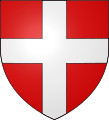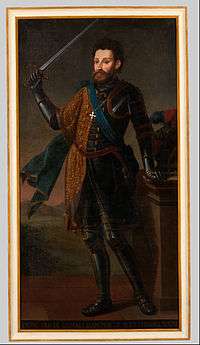Peter II, Count of Savoy
| Peter II, Count of Savoy | |
|---|---|
| Count of Savoy | |
|
Coat of Arms of the Counts of Savoy | |
| Predecessor | Boniface |
| Successor | Philip I |
| Spouse(s) | Agnes of Faucigny |
|
Issue
Beatrice | |
| Noble family | House of Savoy |
| Father | Thomas, Count of Savoy |
| Mother | Margaret of Geneva |
| Born | 1203 |
| Died | 15 May 1268 |
Peter II (1203 – 15 May 1268), called the Little Charlemagne, held the Honour of Richmond, Yorkshire (but not the Earldom) from April 1240 until his death and was Count of Savoy from 1263 until his death. He built the Savoy Palace in London.
Peter was the seventh of nine sons of Thomas I of Savoy and Marguerite of Geneva, and the uncle of Eleanor of Provence, queen-consort of Henry III of England. He was born in Suze in the French County of Albon.
Biography
Early Alpine Career
As a younger son of a noble house, Peter's father started his career in the church, getting him an appointment as a canon at Lausanne, where he worked his way up to acting bishop before a new permanent bishop came in 1231.[1] At that point, Peter had already been growing restless with church life. Upon the death of his father, Peter demanded substantial portions of the County from his eldest brother Amadeus. The brothers all got together in 1234 at Chillon, where they negotiated a settlement which recognized Amadeus as the head of the house. From this, Peter received control of key castles which helped him to expand his control in the area of Geneva. His brother William negotiated a marriage for him with Agnes of Faucigny, which also helped provide territory of his own, so he caused less trouble for his elder brothers.[2]

His desire to further extend his territory led him into conflict with his uncle, William II of Geneva. Around 1236, Peter was ambushed and captured by his cousin Rudolf. When the resulting conflict was concluded in 1237, Amadeus forced William to sign a treaty which required Geneva to pay 20,000 marks and the castle of Arlod.[3] In 1240, when Peter's brother Philip was in a contested election for the Bishop of Lausanne against Jean de Cossonay, a Geneva supported candidate, Peter brought 6000 troops, though the battle did not get resolved decisively.[4]
He continued to use both money and force to take further control of lands surrounding Savoy. In May 1244 Rodolphe III, Count of Gruyère surrendered Gruyères Castle to Peter, who then gave it to William, the 2nd son of Rodolphe with the agreement that William and his heirs would serve Peter and his family.[5] On 29 May 1244 Cossonay similarly surrendered significant territories to Peter and Amadeus, retaining them only under the overlordship of Savoy. He continued to gain control of key towns and trade routes throughout the Pays de Vaud, often by enfeofing them to the younger sons of the previous rulers.[6] He was responsible for the significant renovations of the Château de Chillon, and by 1253 he was the protector of Bern.[7] One scholar suggests that French is the language of western Switzerland due partly to Peter's extensive conquests in the region.[8]
English career
In January 1236, Eleanor of Provence, Peter's niece, married King Henry III. On 20 April 1240 Peter was given the Honour of Richmond by Henry III who invited him to England about the end of the year, and knighted him on 5 January 1241 when he became known popularly as Earl of Richmond although he never assumed the title of Earl, nor was it ever given to him in official documents.[9] In February 1246 he was granted land between the Strand and the Thames,[10] where Peter built the Savoy Palace in 1263, on the site of the present Savoy Hotel. It was destroyed during the Peasants' Revolt of 1381. By his will, the Honour of Richmond was left to his niece queen Eleanor, who transferred it to the crown.[11]
In 1241, Henry sent Peter to gather support for a pending invasion of Poitou. He travelled to Hugh IV, Duke of Burgundy; Theobald I of Navarre; his brother Amadeus IV, Count of Savoy; and his brother-in-law Ramon Berenguer IV, Count of Provence. In February 1242, Peter was sent into Poitou to see what support existed there for Henry. He was nearly captured there, but managed to escape. He then travelled to Provence to negotiate the marriage of his niece Sanchia of Provence to Henry's brother Richard.[12]
In 1246, Peter went back to Savoy, in part to seal a marriage deal with Amadeus. In February 1247, he returned to England with Alice of Saluzzo, Amadeus's granddaughter by Beatrice. She was married to Edmund de Lacy, Baron of Pontefract that May.[13]
Boston (a borough by 1279), on the river Witham, had over many years become an important port for Lincoln. The town was held by the Dukes of Brittany until about 1200. In 1241, Peter obtained the manor of Boston at the same time as he had Richmond. It was restored to John I, Duke of Brittany, on Peter's death. Donington manor is also thought to have been passed from John de la Rye to Peter of Savoy about 1255, when a charter was granted for a market to be held at the manor on Saturdays. In the same year, a similar grant was made for the holding of a fair on 15 August, also to be held at the manor. A separate charter was granted to Peter on 8 April 1255 by the king to hold a market on Mondays.
In 1246, the king granted Peter the castle of Pevensey. Peter sided with Simon de Montfort, Earl of Leicester, in the Second Barons' War; but he eventually left England for France with the queen.
Count of Savoy
When Peter's nephew Boniface, Count of Savoy, died without heirs in 1263, the question of the succession to Savoy lay unanswered. Besides Peter, there was another possible claimant, the fifteen-year-old Thomas III of Piedmont (1248–82), the eldest son of Peter's elder brother Thomas, Count of Flanders. Peter returned to Savoy and was recognised as count over his nephew. This led to a dispute between Savoy and Piedmont that was to outlast Peter and Thomas.
Peter brought many ideas back from his travels around Europe to improve Savoy. He started building castles with a more round form, rather than the square which had existed to that point in Savoy. He divided the county into bailis and divided those into castellanies. He also established an office of accounts at Chambéry to more completely manage financial matters. He was the first count of Savoy to issue laws to cover the whole county.[14]
Peter came into conflict with Rudolf of Habsburg, and Rudolf occupied Peter's lands in the canton of Vaud, including the Château of Chillon. Peter returned from Piedmont in time to lead his troops in retaking the chateau and his lands in 1266.
Already elderly, Peter died without a male heir. Sources differ on the place of his death, some stating that he died in the Château de Chillon so closely associated with him, and others in Pierre-Châtel[15] in the present department of Isère. He was succeeded by his remaining brother, Philip, former Archbishop of Lyon.
Family
Peter's first marriage was to Agnes of Faucigny in 1236. Agnes bore him a daughter, Beatrice (c. 1237 – 21 November 1310). [lower-alpha 1]
Beatrice inherited Faucigny from her mother, giving this territory in the middle of Savoy lands to the Dauphin, who were often opposed to Savoy.[16]
Peter had an illegitimate daughter, Isabelle, who married her cousin Pierre of Salinento, the illegitimate son of Amadeus IV, Count of Savoy.
References
- Calendar of Close Rolls, Henry III, 1242-47. London: British Library. 1916.
- Cox, Eugene L. (1974). The Eagles of Savoy. Princeton: Princeton University Press. ISBN 0691052166.
- Cox, Eugene L. (1967). The Green Count of Savoy. Princeton, New Jersey: Princeton University Press. LCCN 67-11030.
- Wurstemberger, L. (1858). Peter der Zweite. Bern.
Notes
- ↑ Beatrice would marry firstly Count Guigues VII of Viennois and secondly Viscount Gaston VII of Béarn.
- ↑ Cox 1974, p. 16.
- ↑ Cox 1974, p. 40-43.
- ↑ Cox 1974, p. 83-86.
- ↑ Cox 1974, p. 91.
- ↑ Wurstemberger 1858, vol.IV nos. 152, 174.
- ↑ Cox 1974, p. 165-167.
- ↑ Cox 1967, p. 20.
- ↑ Cox 1974, p. 82.
- ↑ Cokayne, George Edward (1945). The Complete Peerage, Vol. 10. The St. Catherine Press. p. 806.
- ↑ British Library 1916, p. 78.
- ↑
 Chisholm, Hugh, ed. (1911). "Richmond, Earls and Dukes of". Encyclopædia Britannica. 23 (11th ed.). Cambridge University Press. p. 306.
Chisholm, Hugh, ed. (1911). "Richmond, Earls and Dukes of". Encyclopædia Britannica. 23 (11th ed.). Cambridge University Press. p. 306. - ↑ Cox 1974, p. 112-115.
- ↑ Cox 1974, p. 168-169.
- ↑ Cox 1967, p. 20-21.
- ↑ Genealogy of the House of Savoie
- ↑ Cox 1967, p. 21.
Succession
| Peter II Born: 1203 Died: 15 May 1268 | ||
| Regnal titles | ||
|---|---|---|
| Preceded by Boniface |
Count of Savoy 1263–1268 |
Succeeded by Philip I |
| Preceded by The Lord de Segrove |
Lord Warden of the Cinque Ports 1241–1255 |
Succeeded by The Lord Cobham |
| Peerage of England | ||
| Preceded by Pierre Mauclerc Forfeited under Henry III |
Earl of Richmond 1241–1268 |
Succeeded by John I |
